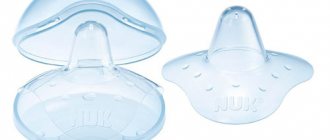Experts:
- Yuri Kopanev, Candidate of Medical Sciences, pediatrician, gastroenterologist-infectious disease specialist, consultant physician at the Moscow Research Institute of Epidemiology and Microbiology named after G. N. Gabrichevsky
- Olga Lovi, psychologist-consultant on the psychology of motherhood, IEAPP GLE-International
Heroine: Zoya Ignatieva, chief accountant, 38 years old
You can hear from old school doctors that there is no point in breastfeeding after 6 months. The World Health Organization recommends that children not be weaned until they are 2 years old. Enthusiastic mothers are ready to continue feeding even until the first grade of school. Where is the truth and who is right in this endless dispute? Our heroine breastfed her daughter until she was 2.5 years old, and continues to breastfeed her 4-year-old son now.
Part 1. Waiting
Like all happy mothers expecting their first baby, I was in a euphoric mood: “I’ll feed myself, it’s so easy.” Moreover, this topic is actively promoted from every iron, and my gynecologist gave me confidence in this regard, for which I thank her very much.
Then for some reason I read a lot of forums, listened to stories of the older generation, and a seed of doubt arose in my soul. Will I be able to breastfeed myself? It turns out that it needs to be prepared as almost the eighth wonder of the world. And then all these mastitis, lactostasis, cracks and hellish pain. What if the baby doesn’t eat enough? What if there is “only water”? What if the breasts “go bad”? In general, a lot of questions, mostly stupid ones, of course, arose. But self-confidence and the habit of listening, first of all, to one’s heart and intuition, cultivated over the years, prevailed over anxious thoughts.
So I didn’t prepare my breasts in any special way, didn’t rub or massage them with anything: just a regular shower and that’s it. Although I don’t argue that breast massage can be useful for your mood, especially when it’s done by your husband. But for breastfeeding this entertaining process has no meaning.
When my little lump screamed for the whole birth and they put him on me, pressing my hand to his butt so that it wouldn’t slip out, I probably felt like a mother for the first time. Nature has it this way that the necessary hormones immediately enter the brain, and you are no longer just the one who carried and gave birth, but you are now a vital person for another creature, very important and dear. Mother.
And so he begins to sip the first drops of colostrum, squint his eyes contentedly and smack his lips. You still don’t even understand how and where to give what, how correctly and what is happening in general, but it is so beautiful that you have no strength to describe. The lump falls asleep, and you feel sick from euphoria... But that's a completely different story!
Second experience
I appreciated all the advantages of breastfeeding, namely the ability to feed at any time and anywhere, the absence of hassle with bottles, the chance to quickly calm the baby in any circumstances with my eldest daughter. So when Grisha was born, there was no question of “to feed or not to feed.” The birth was at home, the baby was put to the breast immediately. Our son had a congenital kidney disease, so we decided to have surgery. I believe that it was breastfeeding that helped us survive the anesthesia and long recovery.
At 6 months, complementary foods were introduced. It was so interesting to watch how the baby, sitting on my lap, demanded borscht for himself. He could be left with his husband, Grisha ate regular food, but latched onto my chest as soon as I crossed the threshold of the house. One winter I had to wean my baby off the breast for a month. I took medicine that is incompatible with breastfeeding. Grisha was 2.3 years old at that time. When I recovered, I returned to the breast again, but the milk did not disappear during this time.
Now Grisha is 4 years old. Only now our feeding is gradually fading away. Sometimes he sucks in the evening before bed. Sometimes in the morning, crawling under my side. Sometimes he doesn’t remember about his breasts for several days in a row. Apparently, the milk that the breasts still produce is enough for him. Since he was three years old, he has been sleeping in his own room and going to the garden full time. I think the weaning will go unnoticed.
Part 2. Reality
In the maternity hospital (and I gave birth in Belarus, in the most ordinary maternity hospital in the small town of Molodechno, without cronyism or agreements), no one was in a hurry to show me the correct technique for putting the baby to the breast and generally explain anything about this, unless you ask. Therefore, I did everything according to intuition, some kind of maternal instinct, and even to the girls who gave birth to second children, no, no, and even suggested something to which they were sincerely surprised.
But no, the head doctor still became interested in the topic of my breasts: while making a round on the third day, for some reason she pressed hard on my chest, until there were stars in my eyes for a couple of seconds from pain, to see what a beautiful fountain the milk would gush out, then wiped it away took a towel from me and stated “well done.” Actually, that was enough for me. “If only they wouldn’t interfere,” I thought then.
But it turned out that if anyone gets in the way, it’s only your own, or someone else’s, prejudices. Oh, the child has lost 10% of his weight! We need to feed it! And here is the mixture already ready in bottles, please take it if you want!
For some reason, no one remembers that this is normal and a child can lose as much weight as he wants after birth, that now he has an important period of adaptation to the new world, outside his mother’s tummy, he is changing and he has more important tasks than food, which By the way, he only needs a few drops in the form of valuable colostrum from his mother’s breast.
But it’s impossible to remember what you never knew. And so it happens: frightened mothers, forgetting about their maternal feelings and common sense, rush to these bottles and feed, feed, feed, so that the treasured numbers on the scales appear. And then, in confusion, they ask the doctors why the child does not poop or strains and cries, or they themselves swallow the tears while the baby is taken away to “shine under the lamp” from jaundice, which is also a normal phenomenon, until the child’s bilirubin has returned to normal. And it is normalized thanks to mother’s colostrum, which contains special proteins for this purpose.
When the doctor, examining my Pakhom, carefully brought him to the window to examine the signs of jaundice, I just smiled at her. “It’s our curtains that are shining,” I joked. Apparently, she understood my joke and didn’t pester us about it anymore. But the neighbor, who was panicking for no reason and who began to shove a bottle into her daughter when rivers of milk were flowing, was convinced to put the girl under a lamp for a day. And I’d better not describe this heartbreaking spectacle, when only our vain worries can serve us badly.
But time passed, and the moment of discharge was approaching. Milk (or rather, colostrum) gradually turned from yellow into white human milk. And it seemed like everything should have been over... But this is where the most beautiful thing begins.
Support Group
The reaction of relatives to long-term breastfeeding was initially ambiguous. I remember, while I was feeding my daughter, my grandfather, foaming at the mouth, argued that feeding a child after a year is harmful. This was told to him by a doctor from the Kremlin clinic where he was being observed. I tried to argue: if milk did not contain useful substances, if its composition did not change with the age of the child, adapting to the needs of the growing body, then the population of underdeveloped countries would simply die out.
With the second child, no one tries to give advice anymore. Friends sometimes joke that I will feed Grisha until the army. Some friends believe that an adult guy who has long distinguished people by gender should not show his breasts.
Part 3. How to establish breastfeeding at home after the maternity hospital
We were discharged on a sunny, cold winter morning. As I remember now, twenty-degree frost, snowdrifts shimmering in the sun, and the joyful eyes of everyone who opened the corner of the blanket to look at Pakhom. Pakhom was awake and also looked at everyone with interest. And then he decided that the time for joy had passed, to realize that there was now a child in the house, and he screamed loudly, or rather, squeaked (what a scream is really became clear about two years later). So the first feeding outside the maternity hospital, feeding in public, which the “knowledgeable” advisers intimidate, went absolutely calmly in the car on the way home. And my first argument in favor of GW was: how convenient it is!
For the first few days at home, the child slept soundly, basking in the rays of love and sunshine from the window. And since I was still new to this business, I, of course, was taught how to feed. Sit down, fold your arms like this, head should be like this, diaper here, legs here, sit for 15 minutes, then take it away. Repeat after three hours. It looked somehow very strange. And uncomfortable. Sitting in a chair is okay, but on the couch? Hmm, my back is stiff, time is up, and the baby has not yet eaten and released the breast. So what should I do? Hints followed immediately: put your little finger in the corner of your mouth, pinch your nose, or even just take it away by force. Pakhom was clearly against these tricks, and I fed him as much as he asked. And she did the right thing, as I later realized.
Part 4. Life apart from advice
In fact, I learned only five months later that you can feed while lying down and even half asleep, sitting in a comfortable chair with a book in your hands, or, which is generally a fantasy for those who are older, while standing and doing your household chores. By this time, we had moved to live separately so far away that the advice of my relatives and doctors remained somewhere far away and could no longer interfere with anything.
A completely different life began with their own, separate family, away from their helpers. I know that many people complain that there are no assistants, that there is only one, that it is difficult. But on the contrary, it was so good and easy for me that I myself can decide what, when, how, what and whether it is necessary at all!
I no longer sat within four walls and did not worry about how I could get there and there in order to return in three hours, I simply took Pakhom with me and went where I needed. Another thing is that sometimes I just didn’t need to go anywhere, I wanted to hug my friend and fall asleep with him for two hours. Then I did just that: and let the whole world wait!
To my surprise, Pakhom began to sleep normally in this situation, for 2-2.5 hours, and not as before, for half an hour and then a cry, which translated means “where is mom?” When your mother is nearby, warms you with her warmth and smells of milk, why be nervous? And at night it also became easier: there is no need to blow yourself up and, like a sleepy owl, fly to the crib, feed, then rock and put him to sleep again. What a happy and contented mother is this?!
“Business,” the baby began tossing and turning, “you secure the connection, and continue to sleep.” Myths about the fact that you can crush a child in your sleep are just myths. I didn’t even hear the alarm clock or the phone when I was sleeping, but I already heard my child snoring or puffing a little and instantly woke up. Here there will be a stronger connection than a rope, at some biochemical level or something. And a normal, adequate and sane sober mother will always hear even the breathing of her baby. And the baby reacts very sensitively to his mother. And if she is not worried, but on the contrary, she is sure that she has a healthy, cheerful, strong man who will sleep on his own and let her sleep, then so it will be. Everything is in our heads!
Part 5. Milk “from the head”
There is also a pandemonium called “I’m not a dairy product” or “milk burned out due to stress.” These are quotes from real girls. At the same time, the facts that, say, even “non-dairy” mammals, for example, beef cows, successfully feed their calves or that milk does not burn out in an instant, even purely on a physiological level, do not bother anyone.
According to folklore, milk is produced by two female hormones: prolactin and oxytocin. The first helps to produce milk so that it is generally in the mammary glands, and the second helps to secrete it, that is, so that it flows out of the breast. And these hormones work only when the baby suckles. At this moment, signals are received in the mother’s brain that it is time to make hormones, the hormones enter the blood, the muscles in the chest that compress the alveoli begin to work, milk is released through special tubes, the milk ducts.
Everything seems so simple and natural, we don’t even think about it. It's like breathing. Nobody taught you, you just started breathing when you were born. It’s the same here, you just need to tune in and believe in it.
No one teaches you to love or feel tenderness (although it’s probably worth opening such courses). Mom takes her little one in her arms, puts him to her chest and simply feels it all at the cellular level. And this connection, physical, then deeper emotional, and after separation, spiritual, transforming and reborn, does not go away, it makes us closer and helps us better understand each other.
Although at the moment when the baby was just born with his eyes wide open, we don’t think about it either, but simply imbue him with the love and care that only we can imbue. And these invisible threads connecting our souls will support us and make us happy for a long time.
So another rule I learned: be confident in yourself in any situation. Listen to your mother's heart, only it knows what is best for your baby. If you want to feed, just relax, love and feed!
Some tips for reducing lactation and breast care
To make weaning painless for a woman, she needs to take care to reduce lactation. Often, when the number of feedings is reduced, the milk decreases on its own, but there are times when this does not happen. The following measures will help reduce lactation:
- Drink less liquid, especially warm liquid, as it only contributes to hot flashes.
- Reduce salt intake. This is necessary in order to eliminate thirst when reducing the amount of fluid consumed.
- If anxiety increases, you can take sedatives. Preference is given to natural preparations - tincture of motherwort or valerian.
- Infusions of mint and sage (3 tablespoons per 250 ml of boiling water) help greatly in reducing lactation. For a good effect, you will need at least 4 glasses of the drink per day. When a decrease in lactation is achieved, the dose can be reduced.
Breast tightening is an undesirable and dangerous way to combat lactation, so it is better not to resort to it. If you have chest pain, you should definitely express a little milk, but only until there is relief, so as not to stimulate lactation. It is not recommended for mother to be in the cold, draft or in contact with cold water, as there is a high risk of inflammation of the mammary glands.
Only the nursing person, namely the mother of the child, has the right to decide when and how to complete breastfeeding, and the advice in the article will help you avoid mistakes and make this process the most painless and correct for mother and baby.
Part 6. About feeding in public
This topic causes a lot of indignation: some are bashfully silent, some argue furiously, and some are disgustedly indignant. I will say this: breastfeeding a child is natural, so I don’t see anything wrong with doing it in front of someone. For a very young child this is a vital need, for a grown-up baby it is no longer such a vital, but still important need, but with older troublemakers you can always come to an agreement, distract and set the boundaries of what is permitted.
No one calls for dumping everything on public display or specifically showing off breasts; on the contrary, any normal mother strives to do this as discreetly as possible: for these purposes, the market has already come up with slings, scarves, capes, aprons, nursing clothes and much more.
But nevertheless, in our society it is considered shameful to expose a piece of the breast in order to give the child mother’s milk. Partly because bare breasts are suggested and perceived as a sexual object, that is, it is taboo, and showing even a millimeter of it to someone else’s eye is very indecent. What arises in the brains of those who are watching, I cannot say, but in my opinion, it is very indecent for them to allow dirty thoughts of this kind. Do you think it's shameful? Do not look!
I have had the opportunity to feed in a public place many times. Mostly until six months, when you run out for a walk, and instead of sleeping, the child bats his eyes, looks at the world, and then asks for food and screams like a siren throughout Ivanovo. Or in the clinic, by the time you visit all the doctors, you yourself will go hungry. Or when you’re with him on your own business, but he’s impatient. In a park, in a public garden, in the city center, in a store, on a visit, in a car, in nature... Where it hits, as they say. And most often those around did not even understand what was happening there, under that apple tree or on that bench. With experience, you will learn to be almost a ninja, who can quickly and comfortably feed your baby, even in the dark, even in a crowd of people.
At the same time, the child is happy: mom is always there, mom is almighty and kind, you can always ask her for food and warmth, and she will share it with you. It’s also convenient for mom: once and everything is ready, fast, free, safe. And the fact that myths, tales and stereotypes of Ochakov’s times live in our heads has long been known. More about myths further.
Part 7. Myths about GW
A complete set of misconceptions about breastfeeding would probably take up at least a volume of fine print. How our mothers, grandmothers, and friends love to retell all sorts of horror stories and fables from mouth to mouth! Few people turn to science and medicine to clarify exciting issues, and I’m generally silent about books. I gave it to my pregnant relative, I tore away from my heart a good book, in the end they didn’t even leaf through it and they finished the pregnancy before they even started...
And I’m sure more than one mother has listened to all sorts of bad advice, when the most important thing seems to be behind her and she just started living with her baby, just start putting all sorts of nonsense into her ears. And you haven’t yet had time to get educated, form your own opinion, and you fall into this trap.
Myth 1. Breastfeeding is something terribly difficult , no one can breastfeed for a long time. In fact, it is very convenient and simple if everything is organized correctly. Make the right effort, get the job done right, listen to your child, and not to someone else who always knows better for some reason.
Myth 2. GW spoils the breasts. Yes, with breastfeeding, breasts from the first size can easily turn into the third or fourth, because after childbirth they consist mainly of glandular tissue, which is filled with milk. Well, if the mother does not feed, then within about a month she is again filled with fatty and connective tissue. And if you participate in another “mad drying” or go on a diet, then of course the shape of your breasts will change: soft breasts intended for feeding will confuse you for a very long time until you return to your normal weight. It’s also worth paying attention to the skin, it’s what sags, and not the breasts at all, if you don’t take care of it. A contrast shower, caring oils or cream, correct posture without the habit of slouching, a bra that fits, less ultraviolet radiation and all sorts of hot baths will help. You can do special exercises to strengthen the pectoral muscles: push-ups and dumbbell presses. Normally, the natural beauty of the breast depends only on this, and also on who looks at it.
Myth 3. GW spoils your figure. If anything spoils your figure, it’s buns, cakes, going to the refrigerator three times at night and lack of movement. After childbirth, a woman’s body returns to its previous shape in about a year or two, and even faster with breastfeeding. For example, within six months I was back to my pre-pregnancy weight, which I was very upset about. I couldn't dial it anymore. My personal trainer, who is also a stylist and nutritionist, who is also my dear Pakhomchik, did not let me get bored. First rush here, then here, then walk, then swing, then throw, then sit down, then bend over, and even if you have time to eat, it’s absolutely beautiful. If you don’t sit straight on your butt, but do sports, for example, even the simplest exercises in the morning, the results will be obvious!
Myth 4. Breasts need to be prepared for feeding. Some “experts” even advise smearing it with something, washing it with antibacterial soap or gel, preferably not with brilliant green. All that can be “prepared” for yourself in this way is dry skin. There is no need to pull out the nipples or rub them with a towel, or use hard cloths. Nature has already thought everything out well. Flat nipples themselves stretch out during feeding, and from rubbing, cracks can form or tone appear. At the same time, the breast protects itself with special glands around it (called Montgomery), so everything is sterile and safe.
Myth 5. You can’t hold your baby to your breast for a long time, otherwise there will be cracks . You need to hold the baby at the breast for as long as he needs to eat or calm down. And apply it correctly, with complete capture of the alveoli. And cracks form precisely because either the baby does not latch onto the breast incorrectly, sliding onto the nipple, and the mother does not “teach” him how to do it correctly (and this is the very first lesson from the mother), or the mother herself treats it with something before feeding. That.
Myth 6. While there is no milk, you need to supplement. Allegedly, in the first days the child starves, receiving only drops of colostrum. No, no and NO! Colostrum is rich in all proteins, vitamins, minerals, antibodies, enzymes, hormones and everything a newborn needs. And he literally needs those same drops, because in the first days his stomach is like a cherry, and after a week it’s like an apricot. How much does he need? But if you supplement your diet, then problems with the mother’s lactation and the child’s digestion are inevitable.
Myth 7: Feeding on demand is a nightmare! This is what mothers say who have failed to learn comfortable feeding. But you just have to want to learn this, in any poses, with pleasure for yourself, and everything will change. If it doesn’t work out, there are consultations on breastfeeding, meetings for slingomas, in the end, books and videos, articles on the Internet, if you wish!
Myth 8. After each feeding you need to express milk, otherwise it will disappear. Well, if you feed your baby after 4 hours, then in order to maintain lactation you will actually have to pump for some time until the milk decreases or disappears completely. After all, it is produced only in response to the baby sucking at the breast. Or if you feed on demand until lactostasis begins from stagnation of excess milk.
Myth 9. Both breasts should be fed at one feeding. For what? Let him first eat everything in one: both the “front”, thinner milk, and the “back”, rich in fats, thicker. If you give two breasts, the baby will receive only the front one, which is rich in lactose, and will risk suffering from lactose intolerance or diarrhea. Let everything be balanced!
Myth 10. Milk “disappeared” due to nerves. The most common myth. I won’t disturb those mothers who still think this way... But it doesn’t go away because of nerves or stress. It disappears from a reluctance to feed, from rare attachments and improper latching on the breast. It disappears from the bottle, which is given immediately, because “it doesn’t fill you up!” From the nerves it is simply blocked by the hormone cortisol and stops flowing (connection with the ancient instinct of self-preservation, when, when frightened in a stressful situation, when, for example, a woman runs from a tiger with a baby under her arm and hides in a cave so that he does not find her, the milk stops flow, and then flow again when she relaxes and feels safe).
Myth 11. A nursing mother must have a strict diet . Why? Why torture yourself with buckwheat and boiled chicken if you haven’t liked them since childhood? Food should be familiar. Do you want chocolate? You can do it too, just without overdoing it. A couple of pieces, look at the child’s reaction - is everything okay? Eat! It's the same with everything else. Citrus fruits, cereals, fruits, berries. Anything is possible, but in moderation, as in ordinary life. Milk is produced not from what we eat, not from the stomach, but from our blood. What went into it went to the child. Therefore, you should not drink alcohol: it is dangerous for children, even in small doses! But the baby’s allergies are not caused by the mother’s food, but by completely different factors: heredity, supplementary feeding with formula in the maternity hospital, early complementary feeding up to six months, preservatives and dyes in food. If you breastfeed only, immediately and as much as required, then, on the contrary, even the first “vaccinations” for possible allergies are laid: with mother’s milk, the baby gets acquainted with a variety of foods. In the maternity hospital, by the way, I didn’t bother with food: they brought me pears, and grapes, and all sorts of compotes, and I ate cabbage, and everything that was given. Pakhom slept soundly, waking up to eat and play a little, was calm and did not cry. The neighbors, it seemed to me, were constantly crying, and one girl, after a sleepless night and the baby’s constipation, simply fell asleep during the doctors’ rounds, and they could not wake her up, she was so tired, poor thing, but they only fed her from a caring bottle. At the same time, they were proud that they did not eat anything so forbidden!
Oh, there are many more myths and tales about GW. And if I remember everything, I can write letters for a long time, but my fingers are already tired. And in general, I got tired of these pens after three years. But if you're interested, let's continue! And the next topic is very pressing, excommunication!
How to end breastfeeding
How and when is it better for a baby to part with “tita”?
And most importantly, is it possible to stop breastfeeding without infringing on the interests of either mother or baby? This is quite possible if you start preparing almost immediately after giving birth. The proposed scheme is ideal, and not everyone will be able to follow it, but the considerations outlined in the article will strengthen the confidence of those mothers who have decided to “give up” breastfeeding. Psychology Preparedness No. 1
There is a popular wisdom: a mother carries a child inside her for 9 months, and then for another 9 months on herself.
In the language of psychology, it means approximately the following: during the first nine months of a child’s life, close physical contact with his mother is very important - this ensures his emotional stability, self-confidence and lays a solid foundation for trust in the world as a whole and each of its representatives individually.
The same idea is easily confirmed from the point of view of the physiology of a growing organism. After all, it is precisely at the age of about 9 months that normally developing children make attempts to walk upright; at the age of about a year - they take their first steps; but in any case, a child of 9-12 months is quite independent in movement (again, provided that he develops adequately and his motor and cognitive activity is not limited). Whether he crawls or walks, the baby notices a lot of interesting things around him (much more than he saw lying on his back and even on his stomach); objects of interest to him become within reach, and mother is no longer the only tempting object.
Later, at the age of one to one and a half years, the child actively masters speech and learns to establish communications with other members of society (whether people or animals). He has something to do besides sucking on his mother’s breasts around the clock in order to satisfy more psychological than physiological needs (and the nutritional value of milk for a child over one and a half years old is very doubtful)…
Thus, everything suggests that breastfeeding at the age of a year and a half can be completed painlessly. Provided that with its end, the emotional contact between mother and child does not stop, but only takes on other (less physiologically determined) forms. This, of course, requires a lot of ingenuity and (I’m not afraid of this word!) mental work from the mother. After all, it’s much easier: to put the breast on the baby, and continue to chat with a friend on the phone, hang out in front of the TV, or even (it’s scary to think :)) sit at the computer!
And it’s a completely different matter: when a child urgently requires his mother’s attention, and such a simple solution as “put a tit in your mouth and everything will pass” is no longer available. In such situations, you still have to tear yourself away from your chair (phone, computer), find out the cause of the children’s sorrows and take adequate measures.
Who is guilty?
Psychologists say: the reasons for problems with stopping breastfeeding are entirely on the mother’s conscience. Precisely conscience, since in most cases, it is precisely the feeling of guilt and the unresolved personal problems lurking behind it that do not allow a mother with a calm heart to take her breast back to herself. If a child develops in a supportive environment, is loved and treated kindly by both his mother and other family members, then at the age of a year and a half he is ready to part with the “tity” himself in order to develop further.
Due to the psychology of this age, he is ready to give his tit to his mother (no matter how much his mother would like to tie him to her forever). After all, just at the age of one year, according to Freud, the oral stage of knowledge of the world in the human psyche is replaced by the anal one:
- Oral – from birth to one year: the child “puts everything in his mouth”, becoming familiar with the concept of “taking”;
- Anal - from one to three years: the child, among other things, shows interest in the potty, mastering the ability to “give”;
- After three years (according to the same Freudian logic), the next stage of development of the child’s psyche begins - genital. Between the ages of three and five years, a person shows a healthy interest in genitals, sexual differences, self-identification by gender and the formation of sexuality are underway...
And one can imagine what happens to the normally developing psyche of a child if, by breastfeeding for up to three years, the mother artificially deprives the child of the anal stage of development, which is so important in terms of personality development!
What is superimposed on what, and what follows from what in this case - it’s even scary to think. SO, if you decide to stop breastfeeding, then the age of a year and a half is the right time for this.
I FORESEE objections from liberal-minded mothers in the spirit that “of course, it’s not the mother who decides when to stop breastfeeding, but the baby himself ceases to need it, and therefore, it’s up to him to determine when it’s time to part with the baby.” Yes, there is such a point of view (and in many ways it is close to me): children in relation to their parents are at the next stage of development, and sometimes they feel better than adults what to do and when.
But it doesn’t take long to go to the other extreme from such reasoning, turning the mother into a raw material appendage and leaving her with only the functions of a nurse. No matter how wise our children are, we are still adults, and children, looking up to mom and dad, expect some actions and explanations from us. Children try to copy our habits (including, by the way, food habits). They not only expect us to introduce certain rules, but also rush to fulfill them with pleasure. Psychologists note: at a certain age, a child very willingly follows the rules, since they give him a sense of stability.
Another important difference between an adult and a child: a parent is able to cover not only the needs of the current moment, but also act, as they say, “for the future.” An adult - no matter how some of us would like to avoid this responsibility - can (unlike a child) foresee and take into account the consequences of the actions that the child takes here and now, based solely on the feelings and desires of the current moment.
Practice
So, after all, how and when to stop breastfeeding so that it goes as smoothly as possible?
Step one: developing a routine
“The beginning of the end” is rooted in infancy: from the age of three months, experts advise switching the child to feeding at intervals of about 3 hours, moving away from the practice of “feeding on demand.” (Looking ahead, I’ll note that the end of breastfeeding itself is an element of the regime, that is, to some extent, it limits the child’s freedom. And it’s better if with restrictions (with the very fact that restrictions in life can actually be) the child will become familiar with it gradually, than if one day the awareness of the need to take into account limitations occurs suddenly and against a background of stress.)
Well, from the point of view of physiology, milk (being a complete food for a child) is digested in the stomach for a very certain time, and it is not worth “diluting” the digested milk by half with a “fresh” portion. I hope for the reader's common sense, however, I will remind you of the rule of the golden mean. Of course, there is no need to grit your teeth and endure the desperate cries of a hungry baby, strictly following the prescribed regimen and waiting the prescribed three hours between feedings. The regime should be established naturally! And believe me, this happens without difficulty when the mother trusts her intuition, and the daily routine of the nursing mother herself is quite stable.
So, a three-hour interval between feedings by the baby’s third month is usually established naturally if:
- the mother learned to listen to the baby and feel his needs;
- in the first months of life, the mother gave the baby breasts when he really needed it (and not when it seemed to her that he needed her, or when it was convenient for her to feed him);
- did not give anything other than breast milk (or water in exceptional cases, for example, during illness).
The regime is the first small step towards parting with the “tity”.
It begins with the fact that the mother no longer offers the baby the breast herself, but also does not refuse him if he persistently asks for it. In this mode - “not offer, but also not refuse” - and trying, if possible, to maintain a 3-hour interval between feedings, mother and baby live for about another three months. And only at the age of about six months does the child first become acquainted with new tastes that differ from mother’s milk.
Step two: introducing complementary foods
The previous stage can be considered preparatory to the introduction of complementary foods. It would seem that at three months no one even thinks about it, the baby doesn’t even have teeth! However, he already knows that, for example, after morning feeding there should be a walk, and after an evening bath - titty and sleep. That is, the child is familiar with the elements of the daily routine, and, accordingly, the nutritional regimen.
The authors of other materials have written well and in detail about how to correctly introduce complementary foods, but here (speaking about the end of breastfeeding) we will only focus on the fact that the introduction of complementary foods in itself is a continuation of weaning.
The child grows, and at the same time his digestive system improves. ...One day he will ride a bicycle (and maybe fly a plane), one day he will learn to use a potty, and a little later, perhaps, he will conquer Everest or another peak... But these exciting moments are, perhaps, a long way off - Now the parents are faced with a simpler task: to teach him to feed himself.
Making sure that learning such simple skills occurs gradually and brings pleasure to the baby, at this stage we focus primarily on the child’s interest in new foods and new tastes. By offering him this or that product (fruit or vegetable puree, porridge or juice), we do not impose on him something that the child clearly does not like. Yes, not all children love broccoli and spinach, although they are among the first healthy and in every sense valuable foods recommended by pediatricians for complementary feeding. The list of these products is quite large - choose what your child likes, and gradually increasing the amount of food eaten, you can first replace one of the breastfeedings, and then more.
By replacing one of the feedings, you will thus, unnoticed by the baby and without harming his digestion, move one more step towards the end of breastfeeding.
Now it's time to finally talk about mom. By the age of six months, one of the feedings - as a rule, first of all in the morning - is already skipped, and therefore there are not three hours left for milk production, as before, but six. Later, one of the evening feedings is also missed, and unnoticed by both participants, twice as much time passes between breastfeedings as before. It’s “unnoticed”, because we agree that we want only the best for the baby (and ourselves!), and therefore we agreed that weaning will happen smoothly.
And so the number of feedings has decreased, figuratively speaking, mother’s “tita” no longer needs to “stand at the stove” every three hours - now you can prepare milk less often. Milk production in a woman’s body (like other functions) is regulated by hormones. Prolactin becomes less, and antagonist hormones take its place - those responsible for menstrual function. It is during this period - when the baby begins to receive complementary foods - that a nursing mother may begin her period, and this is normal.
This is what physiology is all about. We know that hormonal levels are closely related to a person’s psycho-emotional state. Prolactin is a motherhood hormone. There is less of it - the mother feels more free, and gradually begins to leave the baby, “let go” of him and herself. At first, the mother leaves for an hour or two, later this time can increase, but, as always, when it comes to introducing changes, the main thing here is gradualism.
The child, meanwhile, suddenly discovers that life is not so terrible without his mother. Moreover, not only mom’s food tastes good - dad, grandma, and nanny are also able to give him gastronomic pleasure. This is an important moment in psychological terms: the child feels that “with mom, of course, it’s good, but without her it’s not so bad.”
... Once upon a time, today's young (or not so young) parents themselves lived in their parents' house. At some point, they had to leave their father's house in order to develop further, study and learn new things, and finally, build their family. If the children, and their children’s children, and all future generations had remained living in their parents’ house to this day... It’s terrible, it’s even hard to imagine what kind of crush and mutual discontent would have formed 
It is no coincidence that I am talking about this now, because, in fact, a mother’s first short absences from home without a child are, in turn, the first step towards the child leaving the parental family for “independent swimming,” which will happen in 17-20 years. 25…. The fearlessness of our navigator largely depends on how smoothly your child approaches this moment. It’s funny to prevent this and say “this is not soon, this is not about us.” This is about us, the child grows quickly, and time flies unnoticed.
However, having finished this lyrical digression, let us return to the topic of ending breastfeeding.
Step three: encouraging independence
By the year - if the introduction of complementary foods went according to your schedule - the number of feedings has decreased to several times a day, and most of these “several times” occur at night or in the evening. From the point of view of the physiology of a one-year-old child’s body, mother’s milk no longer has the same nutritional value as in the first months of life. Strictly speaking, it may well be replaced by other dairy (or better yet, fermented milk) products.
No, mother’s milk, of course, is still an ideally balanced product for a baby; none of the scientists has yet been able to repeat the formula of breast milk. No adapted formulas are capable of “adjusting” to the needs of the child’s body as much as mother’s milk - its composition changes not only throughout the entire feeding period, but even during the day, but!
The fact is that by the age of one year, the needs of a growing child’s body are no longer satisfied exclusively by mother’s milk. The child has teeth - this is the first signal that he is able not only to suck, but also to bite (and later, chew). And again, let us remember the basic principle of any change - smoothness and gradualness. For about a year (plus or minus 2-3 months), the child from time to time tries to take part in feeding himself - he snatches the spoon from the hands of adults or takes food with his hands. In my opinion, a wonderful manifestation of independence! Why wait for it to fade away? The desire to eat independently needs encouragement (and we said above that all changes are most effective if they are implemented at the moment of greatest interest in them).
Get yourself a tiny spoon that is comfortable for children’s hands (there are a variety of spoons on sale - with a curved handle, thick, plastic or, conversely, miniature, silver, like coffee spoons) and... be patient! When you feed your child porridge, mashed potatoes, or whatever else you feed him, put a spoon in his hand. Naturally, he will smear food on himself, on the table, on you, but you and I understand that there is no malicious intent in this! After all, you didn’t immediately learn, for example, to drive a car - remember your first lessons at the racetrack: now your baby is practically doing the same thing, mastering a new and exciting process.
...I don’t know what the venerable experts will say, but I gave my youngest daughter a fork when she was one year old - Anya just really asked for “adult” forks, but, not knowing how to handle them, she was very upset. I had to buy a tiny (less than a teaspoon) “girl’s fork”... And you should have seen Anyuta’s face when, after several attempts, she finally managed to put food into her mouth with the help of this fork! It was clear that Anya was not so much pleased with the taste of the food as she felt terribly dexterous and as independent as the rest of the family. (Without at all doubting the reader’s sanity, just in case, I’ll still note in parentheses that one-year-old Anya was never left alone with a fork - naturally, such a dangerous device requires adult supervision when it ends up in clumsy children’s hands!)...
The focus on the topic of independent baby feeding is not accidental in the article about the end of breastfeeding - since this is the final stage. After all, when we finish something, we do not die, but simply begin a new stage; and ending breastfeeding, we transfer the child to “human” food. If your baby eats complementary foods with pleasure, you can be congratulated - complete weaning is just around the corner. The most difficult step: giving up night feedings
Let's turn to the mother again - even though she eats ideally, and in addition, supports herself with vitamins, minerals and other supplements, after a year of breastfeeding, the resources of the female body are still significantly depleted. Why then does lactation continue?
The fact is that the hormone prolactin, which is responsible for milk production, is produced not depending on whether the mother is full or not (this, of course, also affects lactation, but more on the quality of milk than on its quantity) - this same prolactin in large quantities quantities are produced at the moment the baby is applied to the breast. The more the baby suckles, the more milk appears. By the way, the notorious pumping, which is so popularly recommended for increasing lactation, has much less effect on milk production than such a simple and natural process as a child sucking at the breast.
So, another feature of prolactin is that this hormone is produced mainly at night. And often, even having completely abandoned daytime feedings and retained night feedings in full, the mother cannot understand why milk production continues intensively? Night feedings are the best way to facilitate this.
So, having decided to “give up” with feedings in general, start giving up night feedings too. How to do this most painlessly? The fact is that a child (among other things) is also forced to nurse at night by the need for carbohydrate foods. Provide a sufficient supply of carbohydrates to the child's body shortly before bedtime, and the baby will sleep better.
...One mother of a two-year-old baby once complained to me that for more than two years she had not been able to sleep - the child woke her up 5-7 times a night, demanding the breast. The mother herself is a vegetarian, and for reasons of “learning to eat healthy,” she fed her son boiled zucchini without salt and sugar in the evenings. Without much enthusiasm, he ate no more than two spoons, and the mother believed that the child was full. Two hours after this “dinner” the boy went to bed; falling asleep, he emptied both of his mother’s breasts, and then literally continued to “hang on his tit” all night. The mother was looking for reasons in the emotional state of the child, until one day she and the baby had to spend the night visiting the grandmother. Secretly from his mother, the grandmother fed her grandson buckwheat porridge, and just before bedtime she also gave him a mug of warm oatmeal with milk. For the first time in his life, the boy went to bed well-fed, and slept without waking up until almost the morning, and his mother jumped up anxiously all night, checking if he was alive...
This is just a story from life, and not a ready-made recipe for feeding before bed. But in any case, nutritionists advise: the child’s evening dinner should be rich in carbohydrates - they will provide him with a restful sleep. I note that zucchini is, of course, also rich in carbohydrates, but, frankly speaking, in order for the child to be satisfied, the food offered must also be tasty.
And the last sensible thought: titya is my mother’s!
However, it is not only physiological mechanisms that explain the difficulty of giving up night feedings. The insidiousness of the moment is also that with the introduction of complementary foods, breastfeeding gradually loses its nutritional function - for the child they increasingly become moments of communication with the mother, moments of no longer physiological, but rather emotional saturation. Closer to one year, the child is well aware of where the mother hides the breast and how to get to it. Some especially skillful toddlers, without hesitation, unbutton the buttons or lift up the T-shirt on their mother and attach themselves to the breast, where and when it is convenient for them.
Psychologists warn against encouraging such a practice: uncontrolled (that is, “on demand”) feeding a child after six months of age forms parasitic, if not despotic, tendencies in a person. He does not learn to feel the boundaries of his own and others’ “I”, and as a result, later experiences difficulties in building relationships with people. After all (let’s take our parental perspective again) each person has a “personal zone”, a sphere of their own interests, which cannot be invaded: and later the child will have to become acquainted for the first time with this simple rule of human “social life” in the sandbox, and will have to face the limitations of his interests in kindergarten and school...
So, at the age of 9-12 months, the child is already smart enough to understand that other people may feel awkward and unpleasant from his actions, and not all of his manifestations bring puppy joy to those around him. And who, if not his mother, will be the first person who will teach him to respect his freedom, but at the same time to value the freedom of others?
“It turned out beautifully,” the parent reading these lines will say. A beautiful ideal model of a gradual, and therefore humane, end of breastfeeding. But what to do if the mother began to think about the fact that all good things come to an end not three months after giving birth, but much later, for example, already planning to go back to work after the required year and a half of maternity leave? If at such a “respectable” age you begin to wean a child who has been breastfed on demand all his life, there will, of course, be more problems with weaning.











